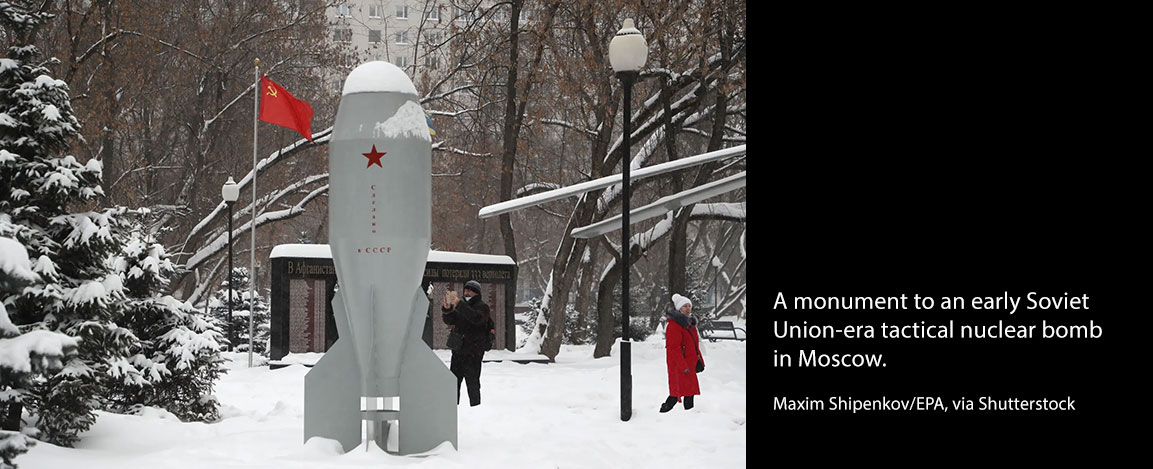Steven Simon, the Robert E Wilhelm Fellow at CIS, and Jonathan Stevenson have worked in government on national security and teach and write extensively about history and politics. This article was first published here in the New York Times.
Mr. Putin has presented strategists with a situation they haven’t really confronted: a rogue actor employing the threat of nuclear weapons for conquest rather than regime survival—the latter being a primary reason for countries like Iran, North Korea and Pakistan to build or deploy nuclear weapons.
In turn, the United States’ posture of restraint with respect to Ukraine may compromise its position elsewhere. For example, a nuclear agreement with Iran, which appears within reach, might be undone if Iran and Israel infer from Washington’s stance that great powers would refrain from exercising conventional military capabilities when their adversaries have nuclear weapons, or if Iran calculates—correctly or not—that Israel would be deterred from resisting a nuclear-armed Iran’s regional projections of conventional power.
During the Cold War, the United States and its allies—most prominently through NATO—developed a framework for conventional and nuclear deterrence. In the 1960s, one of the nation’s leading thinkers on nuclear strategies, Herman Kahn, devised an “escalation ladder” that defined specific levels of military enlargement. The key was to maintain, through perceived military superiority, the capacity to deter an enemy at each level.
What Mr. Putin likely fears is U.S. and NATO conventional military superiority at every level of war except for the nuclear one. Hence his premature nuclear threat, which seems to rule out even limited NATO military options.
As a matter of doctrine, Russia has several conditions for nuclear use, four of which were recently enunciated by Dmitri Medvedev, deputy chairman of the country’s security council: a nuclear weapon is launched against Russia; such a weapon is used against its allies; an actual or impending attack on critical infrastructure to disable Russia’s deterrent nuclear forces; and military aggression of any kind against Russia or its allies that would jeopardize the existence of the Russian state. These scenarios likely involve strategic retaliation against enemy cities or nuclear assets from high-yield weapons launched from long distances.
Like the United States, Russia surely possesses tactical nuclear weapons, which have exponentially less power but could each still yield an explosion of 10 kilotons and potentially up to 50 kilotons of TNT (the Hiroshima bomb’s yield was about 15 kilotons) and would cover relatively short battlefield ranges. It has reportedly been building up its stockpile of these weapons. In issuing the nuclear threat, Mr. Putin implicitly raised a principle, known as “escalate to de-escalate,” under which Russian forces would use low-yield tactical nuclear weapons in Europe to pre-empt large-scale conventional action by NATO. The principle does not fit with any of the doctrinal scenarios above, but it is consistent with Moscow’s capabilities.
Tactical nuclear weapons are destabilizing to the delicate balance of deterrence. They reduce the barrier to nuclear use and blur the boundary between conventional and nuclear war. Russia’s nuclear threat is also most likely imparting additional momentum to the most troubling aspect of U.S. nuclear modernization plans: its own focus on tactical nuclear weapons. Abandoning the Obama administration’s apprehensiveness about such weapons because of their destabilizing effects, the Trump administration’s Nuclear Posture Review contemplated their development in response to the possibility of local and limited aggression — to some extent in response to Russian intimations that it would use the weapons pre-emptively.
If the United States doubled down on tactical nuclear weapons in response to Russia’s threat, it would return the world to a state of nuclear dread similar to what it experienced in the early 1980s. Instead, the United States should reassert confidence in conventional deterrence by emphasizing its adherence to the established framework.
The effort might start with a refutation of Mr. Putin’s narrative, which includes the idea that the invasion of Ukraine was undertaken to pre-empt NATO aggression against Russia staged from Ukraine. This is not credible. NATO’s posture is clearly defensive, involving small forward-positioned NATO deployments that function essentially as a tripwire and a multinational backup force for quick reinforcement to hold the line.
The Biden administration should dial back public disclosures of what it will not do militarily. Such talk implies that the United States and NATO do not believe in the alliance’s deterrence and buy into Mr. Putin’s suggestion that any level of NATO support for Ukraine would risk nuclear war. Putin’s own conduct implies that this isn’t true. Mr. Putin has drawn his red lines: no interference with Russia’s attempted absorption of Ukraine and no arms convoys. Yet the United States and NATO have trespassed over both red lines without facing a Russian riposte. Perpetuating a false sense of Russia’s readiness to use extreme measures only helps Mr. Putin.
Owing to Ukrainian forces’ stiff resistance and the West’s broad support for Ukraine, Russia may be cooling on military conquest and considering a negotiated political solution. Caution is still warranted: Mr. Putin’s true limits remain unclear. The United States should continue to send Ukraine military equipment, especially antiaircraft systems and antitank munitions.
At the same time, the United States and its allies should continue to firm up NATO’s conventional readiness to respond to Russian aggression against a NATO member or on NATO territory, whether it is a result of a deliberate decision or spillover from operations in Ukraine. The message to Mr. Putin is that the United States and NATO emphatically reject his attempt to raze the architecture of deterrence.
Jonathan Stevenson, a senior fellow at the International Institute for Strategic Studies and the managing editor of Survival, served on the National Security Council staff in the Obama administration and is the author of “Thinking Beyond the Unthinkable.” Steven Simon is a fellow at M.I.T. and an analyst with the Quincy Institute for Responsible Statecraft. He served in the State Department and on the National Security Council staff in Republican and Democratic administrations.




